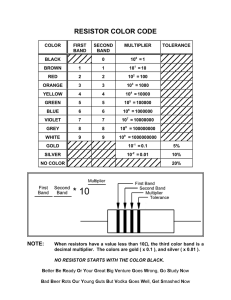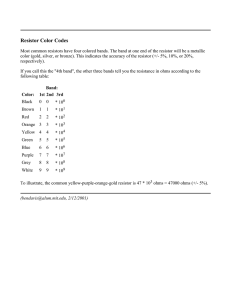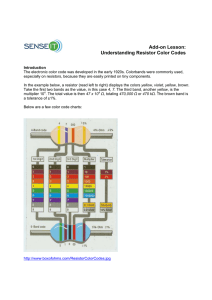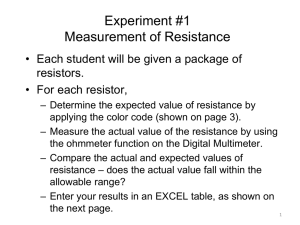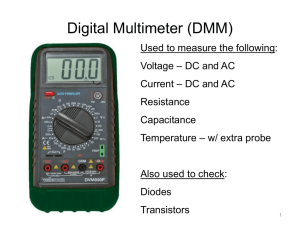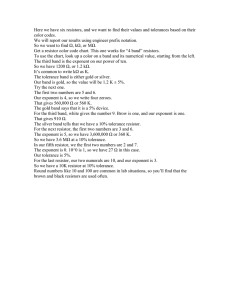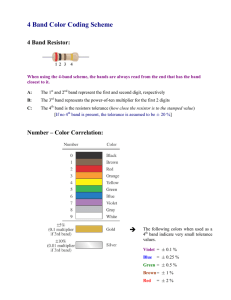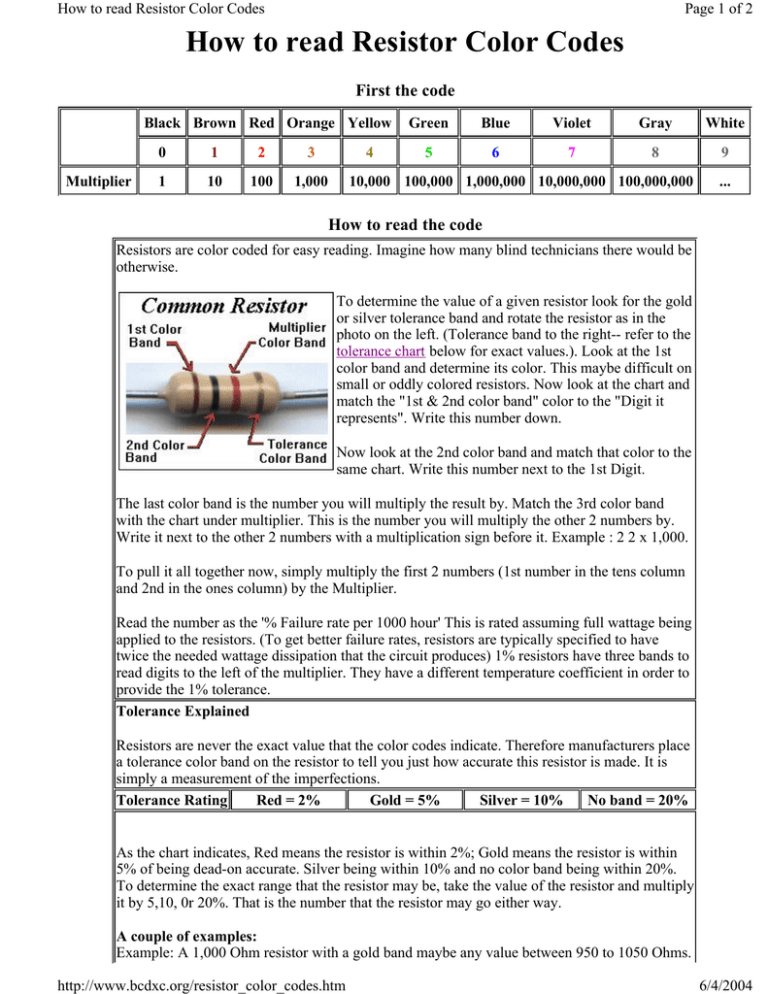
How to read Resistor Color Codes
Page 1 of 2
How to read Resistor Color Codes
First the code
Black Brown Red Orange Yellow
Multiplier
0
1
2
3
1
10
100
1,000
4
Green
Blue
Violet
Gray
White
5
6
7
8
9
10,000 100,000 1,000,000 10,000,000 100,000,000
...
How to read the code
Resistors are color coded for easy reading. Imagine how many blind technicians there would be
otherwise.
To determine the value of a given resistor look for the gold
or silver tolerance band and rotate the resistor as in the
photo on the left. (Tolerance band to the right-- refer to the
tolerance chart below for exact values.). Look at the 1st
color band and determine its color. This maybe difficult on
small or oddly colored resistors. Now look at the chart and
match the "1st & 2nd color band" color to the "Digit it
represents". Write this number down.
Now look at the 2nd color band and match that color to the
same chart. Write this number next to the 1st Digit.
The last color band is the number you will multiply the result by. Match the 3rd color band
with the chart under multiplier. This is the number you will multiply the other 2 numbers by.
Write it next to the other 2 numbers with a multiplication sign before it. Example : 2 2 x 1,000.
To pull it all together now, simply multiply the first 2 numbers (1st number in the tens column
and 2nd in the ones column) by the Multiplier.
Read the number as the '% Failure rate per 1000 hour' This is rated assuming full wattage being
applied to the resistors. (To get better failure rates, resistors are typically specified to have
twice the needed wattage dissipation that the circuit produces) 1% resistors have three bands to
read digits to the left of the multiplier. They have a different temperature coefficient in order to
provide the 1% tolerance.
Tolerance Explained
Resistors are never the exact value that the color codes indicate. Therefore manufacturers place
a tolerance color band on the resistor to tell you just how accurate this resistor is made. It is
simply a measurement of the imperfections.
Tolerance Rating
Red = 2%
Gold = 5%
Silver = 10%
No band = 20%
As the chart indicates, Red means the resistor is within 2%; Gold means the resistor is within
5% of being dead-on accurate. Silver being within 10% and no color band being within 20%.
To determine the exact range that the resistor may be, take the value of the resistor and multiply
it by 5,10, 0r 20%. That is the number that the resistor may go either way.
A couple of examples:
Example: A 1,000 Ohm resistor with a gold band maybe any value between 950 to 1050 Ohms.
http://www.bcdxc.org/resistor_color_codes.htm
6/4/2004
How to read Resistor Color Codes
Page 2 of 2
Example: A 22,000 Ohm resistor with a silver band maybe any value between 19,800 and
24,200 Ohms.
Resistor FAQ's
Just a few common questions to help you out.
1) Which side of the resistor do I read from?
The Gold or Silver band is always set to the right, then you read from left to right. Sometimes
there will be no tolerance band -- Simply find the side that has a band closest to a lead and
make that the first band.
2) Sometimes the colors are hard to make out. How do I make certain what the value of
the resistor really is?
Occasionally the colors are jumbled or burnt off. The only way to read it then is with a multimeter across the leads
3) How do I remember this sequence of colors?
Remember the color codes with this sentence: Big Brown Rabbits Often Yield Great Big
Vocal Groans When Gingerly Slapped.
Last modified February 08, 2004 by Paul B. Peters, Show contact information
Copyright © 2000 -2003 Paul B. Peters, VE7AVV. All rights reserved.
http://www.bcdxc.org/resistor_color_codes.htm
6/4/2004

